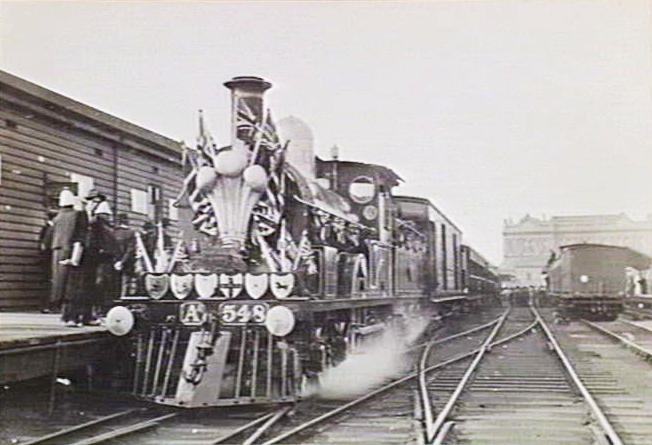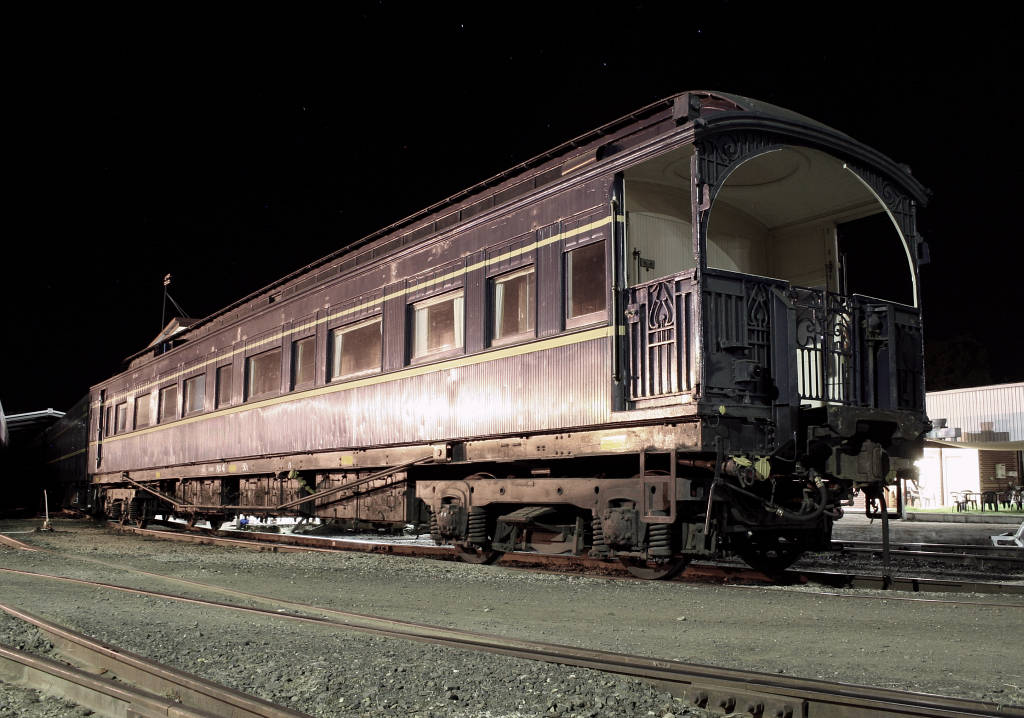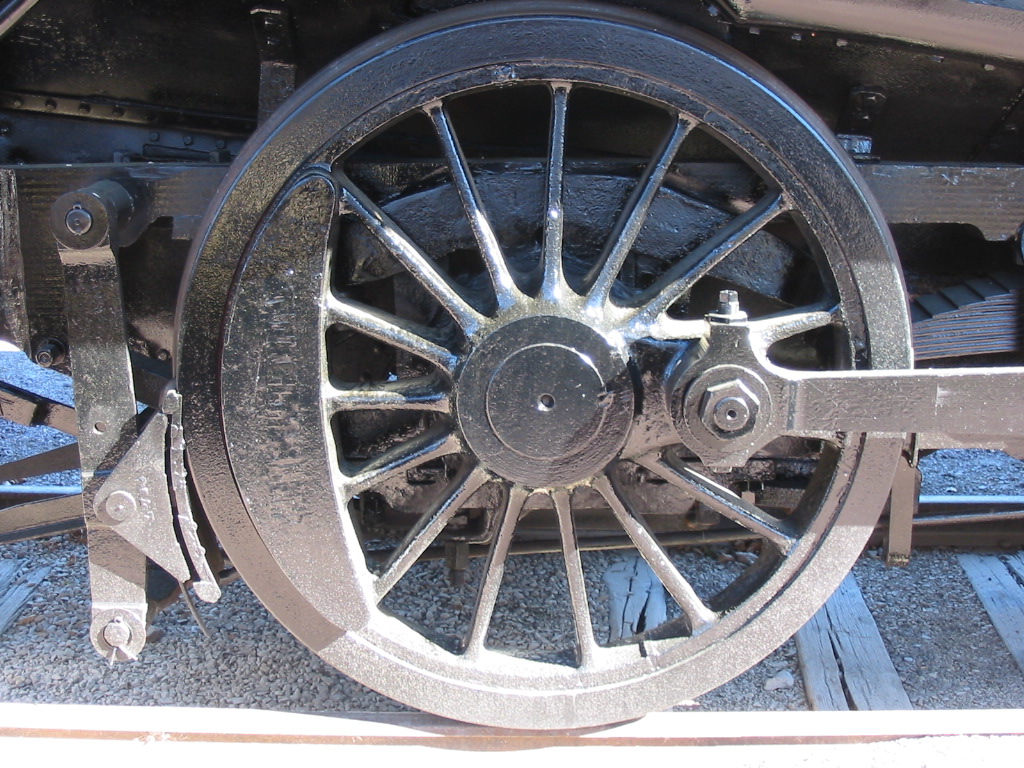|
Victorian Railways AA Class
The AA class was an express passenger locomotive that ran on the Victorian Railways between 1900 and 1932. The largest, heaviest and most powerful 4-4-0 steam locomotive to run in Australia, it was the final development of this locomotive type in Australia. History In 1900, Victorian Railways still ran express passenger trains with the successful but ageing B class 2-4-0 which dated back to 1862. The 'New A' class 4-4-0 of 1889 had proven to be a successful design, as had its close cousin and exact contemporary the X class 0-6-0. With traffic needs continuing to grow, the VR drafting office decided to take the best features of the New A and X class, but enlarge the locomotive with a larger, higher pressure boiler and larger cylinders. Design features Innovative design features of the AA class included air sanding equipment, improved Gresham No. 9 injectors, horizontal grid spark arrestors, steam for auxiliaries supplied directly from the dome, and a sloped ashpan to provide eas ... [...More Info...] [...Related Items...] OR: [Wikipedia] [Google] [Baidu] |
Phoenix Foundry
The Phoenix Foundry was a company that built steam locomotives and other industrial machinery in the city of Ballarat, Victoria, Ballarat, Victoria (Australia), Victoria, Australia. Over 30 years they built 352 locomotives for the Victorian Railways, of 38 different designs. History The Phoenix Foundry was established in 1854 to build mining machinery and was incorporated as the Phoenix Foundry Co. Ltd. in 1870. The company was established by iron-founder William Shaw (engineer), William Shaw, moulder Robert Holden (engineer), Robert Holden, and engine-smiths Richard Carter (engineer), Richard Carter and George Threlfall (engineer), George Threlfall. The business prospered, and by November 1861 it employed 96 men, producing a wide range of products. From around 1858 the employees were working an eight-hour day while doing as much work as English workers did in ten hours. In 1871 Phoenix completed the locomotive named ''Governor Weld'' which was the first steam locomotive to op ... [...More Info...] [...Related Items...] OR: [Wikipedia] [Google] [Baidu] |
Steam Dome
The steam dome is a vessel fitted to the top of the boiler of a steam engine. It contains the opening to the main steam pipe and its purpose is to allow this opening to be kept well above the water level in the boiler. This arrangement acts as a simple steam separator and minimises the risk that water will be carried over to the cylinders where it might cause a hydraulic lock, also known as priming. A steam dome should not be confused with a sand dome. Railway locomotives The first locomotive with a deliberate dome added to the boiler barrel was Stephenson's 'Phoenix' an 0-2-2 for the Liverpool and Manchester Railway in 1830. Many other locomotives built from the late 1830s instead used either the 'haycock' boiler, where the firebox outer casing was raised high above the main part of the boiler, forming a steam dome, or Gooch's development of this where the semi-cylindrical firebox wrapper was raised above the boiler barrel. The most vigorous boiling in a locomotive boile ... [...More Info...] [...Related Items...] OR: [Wikipedia] [Google] [Baidu] |
Horse Racing
Horse racing is an equestrian performance sport, typically involving two or more horses ridden by jockeys (or sometimes driven without riders) over a set distance for competition. It is one of the most ancient of all sports, as its basic premise – to identify which of two or more horses is the fastest over a set course or distance – has been mostly unchanged since at least classical antiquity. Horse races vary widely in format, and many countries have developed their own particular traditions around the sport. Variations include restricting races to particular breeds, running over obstacles, running over different distances, running on different track surfaces, and running in different gaits. In some races, horses are assigned different weights to carry to reflect differences in ability, a process known as handicapping. While horses are sometimes raced purely for sport, a major part of horse racing's interest and economic importance is in the gambling associated with ... [...More Info...] [...Related Items...] OR: [Wikipedia] [Google] [Baidu] |
Agricultural Show
An agricultural show is a public event exhibiting the equipment, animals, sports and recreation associated with agriculture and animal husbandry. The largest comprise a livestock show (a judged event or display in which selective breeding, breeding stock is exhibited), a trade fair, competitions, and entertainment. The work and practices of farmers, animal fancy, animal fanciers, cowboys, and zoologists may be displayed. The terms ''agricultural show'' and ''livestock show'' are synonymous with the North American terms county fair and state fair. History The first known agricultural show was held by Salford Agricultural Society, Lancashire, in 1768. Events Since the 19th century, agricultural shows have provided local people with an opportunity to celebrate achievements and enjoy a break from day-to-day routine. With a combination of serious competition and light entertainment, annual shows acknowledged and rewarded the hard work and skill of primary producers and provided a ... [...More Info...] [...Related Items...] OR: [Wikipedia] [Google] [Baidu] |
4-6-0
A 4-6-0 steam locomotive, under the Whyte notation for the classification of steam locomotives by wheel arrangement, has four leading wheels on two axles in a leading bogie and six powered and coupled driving wheels on three axles with the absence of trailing wheels. In the mid-19th century, this wheel arrangement became the second-most-popular configuration for new steam locomotives in the United States, where this type is commonly referred to as a ten-wheeler.White, John H., Jr. (1968). ''A history of the American locomotive; its development: 1830-1880''. New York, NY: Dover Publications. p. 57. As locomotives pulling trains of lightweight all-wood passenger cars from the 1890 to the 1920s, they were exceptionally stable at near speeds on the New York Central's New York-to-Chicago Water Level Route and on the Reading Railroad's line from Camden to Atlantic City, New Jersey. Overview Tender locomotives During the second half of the nineteenth and first half of the twenti ... [...More Info...] [...Related Items...] OR: [Wikipedia] [Google] [Baidu] |
Victorian Railways A2 Class
The A2 class was an express passenger locomotive that ran on Victorian Railways from 1907 to 1963. A highly successful design entirely the work of Victorian Railways' own design office, its long service life was repeatedly extended as the Great Depression and later World War II delayed the introduction of more modern and powerful replacement locomotives. History The introduction of the A2 class marked a turning point in Victorian Railways locomotive design, as it was entirely designed by VR engineers of the newly established Locomotive Design Section and the entire class built in-house at Victorian Railways workshops.Pearce et al., p. 12 Production Based on the success of the prototype A2572, a total of 125 Stephenson valve gear A2 locomotives were built between 1907 and 1915. The design was then altered to incorporate larger diameter cylinders, a higher pressure boiler and Walschaerts valve gear, and a further 60 locomotives of that design were produced between 1915 and 1922. ... [...More Info...] [...Related Items...] OR: [Wikipedia] [Google] [Baidu] |
E Type Carriage
The E type carriages were wooden express passenger carriage used on the railways of Victoria, Australia. Originally introduced by Victorian Railways Chairman of Commissioners Thomas James Tait for the interstate service between Melbourne, Sydney and Adelaide, these Canadian-inspired carriages remained in regular service for 85 years over the entire Victorian network. Design Carriages on Victorian long-distance express services at the start of the 20th century were, in comparison to the Pullman cars operated by the New South Wales Government Railways, relatively cramped and austere. Chairman of Commissioners Thomas Tait, previously the Transportation Manager of the Canadian Pacific Railway, introduced a carriage design that was long, and as wide as the loading gauge allowed. Much of their external appearance was based on typical Canadian carriage design, with a clerestory roof curved at the ends, doors only at the ends of the car, and six-wheel bogies, although their inte ... [...More Info...] [...Related Items...] OR: [Wikipedia] [Google] [Baidu] |
Mary Of Teck
Mary of Teck (Victoria Mary Augusta Louise Olga Pauline Claudine Agnes; 26 May 186724 March 1953) was List of British royal consorts, Queen of the United Kingdom and the British Dominions, and Empress of India, from 6 May 1910 until 20 January 1936 as the wife of King-Emperor George V. Born and raised in the United Kingdom of Great Britain and Ireland, United Kingdom, Mary was the daughter of Francis, Duke of Teck, a German nobleman, and Princess Mary Adelaide of Cambridge, a granddaughter of King George III and a minor member of the British royal family. She was informally known as "May", after the month of her birth. At the age of 24, she was betrothed to her second cousin once removed Prince Albert Victor, Duke of Clarence and Avondale, the eldest son of the Edward VII, Prince of Wales and second in line to the throne. Six weeks after the announcement of the engagement, he died unexpectedly during an 1889–1890 pandemic, influenza pandemic. The following year, she became ... [...More Info...] [...Related Items...] OR: [Wikipedia] [Google] [Baidu] |
George V Of The United Kingdom
George V (George Frederick Ernest Albert; 3 June 1865 – 20 January 1936) was King of the United Kingdom and the British Dominions, and Emperor of India, from 6 May 1910 until his death in 1936. Born during the reign of his grandmother Queen Victoria, George was the second son of Albert Edward, Prince of Wales, and was third in the line of succession to the British throne behind his father and his elder brother, Prince Albert Victor. From 1877 to 1892, George served in the Royal Navy, until the unexpected death of his elder brother in early 1892 put him directly in line for the throne. On Victoria's death in 1901, George's father ascended the throne as Edward VII, and George was created Prince of Wales. He became king-emperor on his father's death in 1910. George's reign saw the rise of socialism, communism, fascism, Irish republicanism, and the Indian independence movement, all of which radically changed the political landscape of the British Empire, which itself reache ... [...More Info...] [...Related Items...] OR: [Wikipedia] [Google] [Baidu] |
Victorian Railways Royal Train
The Victorian Railways' (VR) Royal Trains operated to transport members of the Royal Family on their numerous tours of Australia on the Victorian rail network. The same carriages were also used for a number of vice-regal trains for the Governor-General of Australia and the Governor of Victoria. The last Royal Train ran in 1988. Operation Royal trains usually operated with special carriage stock set aside for the purpose. Most trains operated with double headed locomotives to reduce the chance of the train being stranded due to locomotive failure, with a third locomotive running in front of the train to ensure the track was clear. A special headboard with the royal coat of arms was usually affixed to the front of the leading locomotive. Carriages In the history of the Victorian Railways there were five special carriages designated for royal train and other special services, designated State Car 1 through to State Car 5. From 1954, the carriages were painted in the standard ... [...More Info...] [...Related Items...] OR: [Wikipedia] [Google] [Baidu] |
AA 548 Decorated Royal Train
AA, Aa, Double A, or Double-A may refer to: Arts, entertainment and media * '' America's Army'', a 2002 computer game published by the U.S. Army * ''Ancient Anguish'', a computer game in existence since 1992 * Aa!, a J-Pop musical group * Double-A (band), stylised as AA, South Korean boy band * ''Aa'' (album), a 2016 album by Baauer * AA (song), a 2021 single by Walker Hayes * Ace Attorney, a series of video games developed by Capcom. * AA Films, an Indian film distribution company *AA Book (other) *AA, the production code for the 1966 ''Doctor Who'' serial '' The Savages'' Brands, organizations and enterprises * Alcoholics Anonymous, an international fellowship dedicated to helping alcoholics peer to peer in sobriety * A. A. Arms, a defunct firearms manufacturer * Aerolíneas Argentinas, an Argentine airline (logo used to consist of two A's) * Air Asia, an Asian multinational low cost carrier * Alcoa, an American aluminum-producing company (stock symbol AA) * Am ... [...More Info...] [...Related Items...] OR: [Wikipedia] [Google] [Baidu] |
Factor Of Adhesion
An adhesion railway relies on adhesion traction to move the train. Adhesion traction is the friction between the drive wheels and the steel rail. The term "adhesion railway" is used only when it is necessary to distinguish adhesion railways from railways moved by other means, such as by a stationary engine pulling on a cable attached to the cars or by railways that are moved by a pinion meshing with a rack. The friction between the wheels and rails occurs in the wheel-rail interface or contact patch. The traction force, the braking forces and the centering forces, all contribute to stable running. However, running friction increases costs by requiring higher fuel consumption and by increasing the maintenance needed to address fatigue (material) damage, wear on rail heads and on the wheel rims and rail movement from traction and braking forces. Variation of friction coefficient Traction or friction is reduced when the top of the rail is wet or frosty or contaminated with greas ... [...More Info...] [...Related Items...] OR: [Wikipedia] [Google] [Baidu] |











